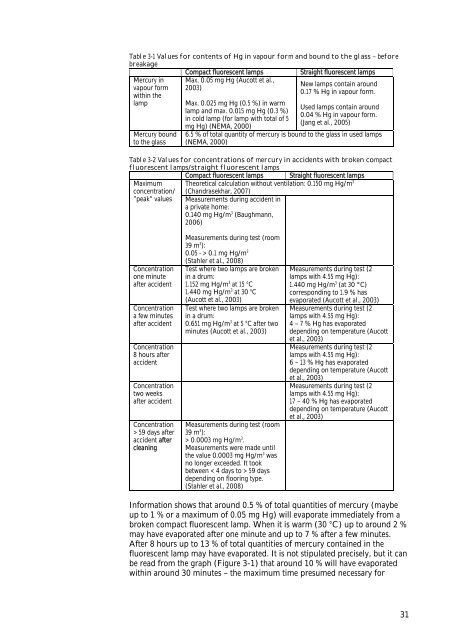No. 104 - Miljøstyrelsen
No. 104 - Miljøstyrelsen
No. 104 - Miljøstyrelsen
You also want an ePaper? Increase the reach of your titles
YUMPU automatically turns print PDFs into web optimized ePapers that Google loves.
Table 3-1 Values for contents of Hg in vapour form and bound to the glass – before<br />
breakage<br />
Mercury in<br />
vapour form<br />
within the<br />
lamp<br />
Mercury bound<br />
to the glass<br />
Compact fluorescent lamps Straight fluorescent lamps<br />
Max. 0.05 mg Hg (Aucott et al.,<br />
2003)<br />
Max. 0.025 mg Hg (0.5 %) in warm<br />
lamp and max. 0.015 mg Hg (0.3 %)<br />
in cold lamp (for lamp with total of 5<br />
mg Hg) (NEMA, 2000)<br />
New lamps contain around<br />
0.17 % Hg in vapour form.<br />
Used lamps contain around<br />
0.04 % Hg in vapour form.<br />
(Jang et al., 2005)<br />
6.5 % of total quantity of mercury is bound to the glass in used lamps<br />
(NEMA, 2000)<br />
Table 3-2 Values for concentrations of mercury in accidents with broken compact<br />
fluorescent lamps/straight fluorescent lamps<br />
Maximum<br />
concentration/<br />
Compact fluorescent lamps Straight fluorescent lamps<br />
Theoretical calculation without ventilation: 0.150 mg Hg/m 3<br />
(Chandrasekhar, 2007)<br />
”peak” values Measurements during accident in<br />
a private home:<br />
0.140 mg Hg/m 3 (Baughmann,<br />
2006)<br />
Concentration<br />
one minute<br />
after accident<br />
Concentration<br />
a few minutes<br />
after accident<br />
Concentration<br />
8 hours after<br />
accident<br />
Concentration<br />
two weeks<br />
after accident<br />
Concentration<br />
> 59 days after<br />
accident after<br />
cleaning<br />
Measurements during test (room<br />
39 m 3 ):<br />
0.05 - > 0.1 mg Hg/m 3<br />
(Stahler et al., 2008)<br />
Test where two lamps are broken<br />
in a drum:<br />
1.152 mg Hg/m3 at 15 °C<br />
1.440 mg Hg/m3 at 30 °C<br />
(Aucott et al., 2003)<br />
Test where two lamps are broken<br />
in a drum:<br />
0.651 mg Hg/m3 at 5 °C after two<br />
minutes (Aucott et al., 2003)<br />
Measurements during test (room<br />
39 m 3 ):<br />
> 0.0003 mg Hg/m 3 .<br />
Measurements were made until<br />
the value 0.0003 mg Hg/m 3 was<br />
no longer exceeded. It took<br />
between < 4 days to > 59 days<br />
depending on flooring type.<br />
(Stahler et al., 2008)<br />
Measurements during test (2<br />
lamps with 4.55 mg Hg):<br />
1.440 mg Hg/m 3 (at 30 °C)<br />
corresponding to 1.9 % has<br />
evaporated (Aucott et al., 2003)<br />
Measurements during test (2<br />
lamps with 4.55 mg Hg):<br />
4 – 7 % Hg has evaporated<br />
depending on temperature (Aucott<br />
et al., 2003)<br />
Measurements during test (2<br />
lamps with 4.55 mg Hg):<br />
6 – 13 % Hg has evaporated<br />
depending on temperature (Aucott<br />
et al., 2003)<br />
Measurements during test (2<br />
lamps with 4.55 mg Hg):<br />
17 – 40 % Hg has evaporated<br />
depending on temperature (Aucott<br />
et al., 2003)<br />
Information shows that around 0.5 % of total quantities of mercury (maybe<br />
up to 1 % or a maximum of 0.05 mg Hg) will evaporate immediately from a<br />
broken compact fluorescent lamp. When it is warm (30 °C) up to around 2 %<br />
may have evaporated after one minute and up to 7 % after a few minutes.<br />
After 8 hours up to 13 % of total quantities of mercury contained in the<br />
fluorescent lamp may have evaporated. It is not stipulated precisely, but it can<br />
be read from the graph (Figure 3-1) that around 10 % will have evaporated<br />
within around 30 minutes – the maximum time presumed necessary for<br />
31

















